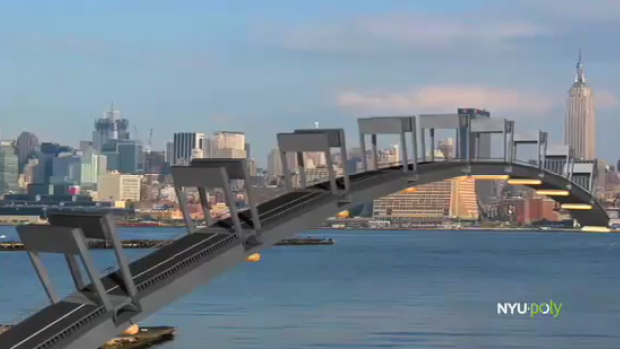Inno/Vention: students create 'the next big thing'

“I will turn blueprints into bridges,” reads one of the advertisements from Polytechnic Institute of NYU’s award-winning “I will” campaign. Civil engineering major Benjamin Kanner (class of 2011), second place winner of the second annual Time Warner Cable Inno/Vention student idea competition, may just be the person to make that inspirational ad become a reality.
Mr. Kanner’s “magnetic flexible bridge” literally turns conventional suspension bridge design on its head. Instead of suspension cables attached to towers cemented down to bedrock, Mr. Kanner’s design calls for a series of hinged segments that get the strength to stay in a convex-arch shape from pillars that tower above the ends of each segment. The repelling force of giant magnets on pairs of adjacent pillars creates the force that holds the bridge up. The bridge’s ends — which serve as entrance and exit ramps — are the only points that make contact with the ground. Mr. Kanner holds a provisional patent on his design.
Mr. Kanner’s invention is especially timely given President Barack Obama’s pledge to fund large-scale infrastructure projects. In fact, many of the semi-finalist’s entries address a pressing issue like alternative energy, or capitalize on a growth market like smartphones.
Creating a product or service that fulfills an unmet need is arguably the surest way to be a successful inventor or entrepreneur. NYU-Poly President Jerry M. Hultin reminded students at the Inno/Vention awards luncheon that many unmet needs are waiting to be filled in the wake of the global economic downturn.
“The world has broken apart; you have the opportunity to put it back together,” President Hultin told the semi-finalists. “People are scrambling for the next big thing.”
The next big thing will likely relate to energy, like the first- and third-place ideas: Christopher LoBello’s “thermoelectric alternator” and Michael Hailemariam’s “Bio-Chill,” respectively.
Mr. LoBello, a senior physics major, is a veteran of the Inno/Vention contest. Last year, his team took first place for their process to create carbon nanotubes lined with titanium that can safely store hydrogen and potentially power cars. This year, Mr. LoBello went solo and designed an alternator that captures the waste heat from a vehicle’s exhaust system and passes it through thermoelectric devices that turn heat into electricity. Mr. LoBello’s invention makes it possible for that re-used energy to power the car’s radio, phone charger, and other peripherals, thereby lessening demand on the engine which fuels conventional alternators.
Anyone who has used their laptop on their actual lap for an extend period of time knows how hot they get. Mr. Hailemariam’s (Chemical and Biological Engineering, 2010) Bio-Chill could change that by using DNA, of all things.
DNA can be engineered to lose its chemical structure at a selected temperature. As it unwinds, it absorbs heat. Mr. Hailemariam’s winning idea is to engineer DNA to lose its double helix at the core temperature of an electronic device such as a laptop. The custom DNA would be stored in a polymer film of water-based solution attached to the laptop, or other electronic device. As the laptop heats up the hardware, the DNA would unwind, absorb heat, and enable the thermal management of the machine to cool the laptop, making it comfortable for actual laps.
Theresa Luback and Raymond Ye’s DormStop.com, an e-commerce website targeted to college students entering their first year of dorm life, tied with Bio-Chill for third place. DormStop.com’s creators envision “stores” for each college with approved dorm gear for sale. By partnering with large retailers like Bed, Bath, and Beyond, Ms. Luback (Construction Management, 2009; Civil Engineering, 2007) and Mr. Ye (Mechanical Engineering, 2010) plan to purchase at discounted prices and charge students for the convenience and service of pre-ordering items that they know are allowed in their rooms. For even more assurance that they’re making the right purchase, students can use the “3-D try on” feature which allows them to place items they like in 3-D models of their actual dorm rooms.
The first Inno/Vention competition began shortly after NYU-Poly launched its i2e (invention, innovation, and entrepreneurship) initiative in 2007 as a way to jumpstart a culture of intellectual curiosity and risk-taking.
The number of entries doubled this year, according to Dean of Student Affairs Michael Hutmaker. Dr. Hutmaker also said that improvements were made to the competition to make it more rewarding. For example, faculty advisors partnered with students to give guidance as they worked on their inventions over Inno/Vention’s semester-long design phase. Dr. Hutmaker co-created Inno/Vention with Bruce Niswander, director of BEST, NYU-Poly’s business incubator.




